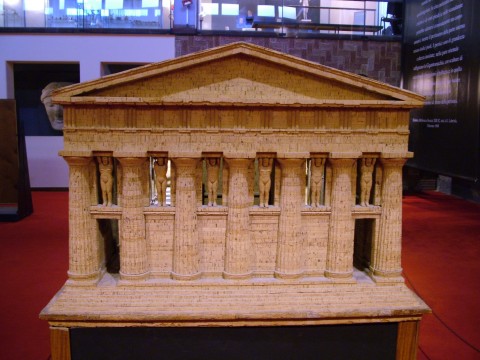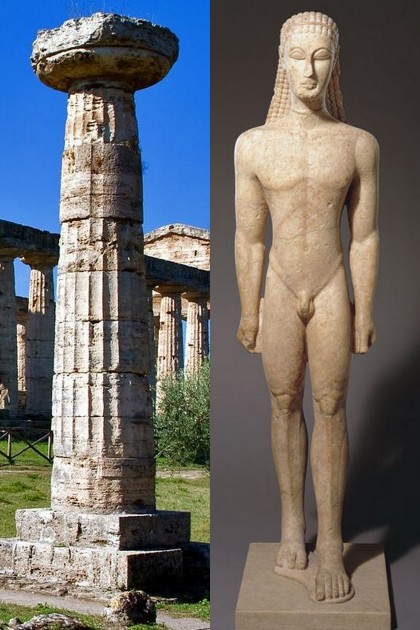Wednesday, May 6th, 2015
The “Nude” Doric Column
This week I am teaching my ancient art students about Greek art. On Monday we explored how kouroi from the Archaic period consisted of nude male figures (see example above), whereas female korai were always clothed. It wasn’t until the Late Classical period that the female nude became a traditional subject in Western art (perhaps forever more, for better or worse!).
Then, today, we explored Vitruvius’ discussion of the Doric and Ionic orders as being “gendered” (with the Doric order compared to a male and the Ionic order compared to a female). I pointed out that Vitruvius compared the fluted shaft of the Ionic column to the folds of a matronal garment, and then read this translation of De Architectura: “Thus two orders were invented, one of a masculine character, without ornament, the other bearing a character which resembled the delicacy, ornament, and proportion of a female” (Vitruvius, 4:1:7).
At that point, I had a student ask if the Doric order was supposed to be perceived as nude, since the Ionic order was described as clothed. Given our discussion of nude kouroi and and clothed korai earlier this week, I thought this was an excellent question. And it actually was easy to discover after class that my student made a correct observation! The original Latin text by Vitruvius contains a slightly different description than the English translation I have been using, describing the Doric order as “unam virili sine ornatu nuda specie” (a male, naked and unadorned; 4.1.17).
I feel like the inclusion of “nuda specie” really changes the way that one thinks of the Doric order, and I wish that this detail was stressed more in English translations of Vitruvius. I did find this English translation which includes the naked reference, and I think I will use this translation from hereon out.
So, if Doric columns are nude, do these columns stand as references to of heroism or warriors, similar to the nude kouroi? Perhaps. I found a book called The Lost Meaning of Classical Architecture by George L. Hersey which takes this idea of the “male” Doric columns further, arguing that the columns are representative of the Dorian invaders (nude warriors).1 He even finds that the entasis (slight swelling of the columns) perhaps suggestive of the straining of the human body.2 Although I’m not completely convinced that these Doric temples were supposed to be lined with the bodies of dynamic, straining warriors, it is an interesting and unique interpretation. What do others think?

Model of the Temple of Zeus at Agrigento, Sicily (original perhaps begun c. 480 BE, although still under remodel in 2nd century BC and never completed).
Also, this topic has also gotten me to think about male and female architectural supports and ornaments, known respectively as atlantes (also called atlantids or telemons) and caryatids. It is interesting that the female caryatid figures are depicted as clothed (I am not aware of a single nude example), whereas the ancient male counterparts, the atlantes, are nude. Additionally, it appears that atlantes were used in a Doric context.3 The earliest example of atlantes figures appear at the Temple of Zeus at Agrigento, Sicily (shown in reconstruction above, and the remnants of one such atlantis can be seen HERE). Although these specific figures did not serve as columns but were placed between Doric columns, they appear to still have at least some load-bearing capacity and perhaps could have emphasized the perceived “nudity” of the Doric columns themselves.
1 George L. Hersey, The Lost Meaning of Classical Architecture: Speculations on Ornament from Vitruvius to Venturi (Cambridge, MA: MIT Press, 1988), p. 58. Available online HERE.
2 Ibid.
3 Dorothy King, “Vitruvius, Caryatids, and Telemones.” Available online HERE. An alternate version of this article appears in Dorothy King, “Figured supports: Vitruvius’ Caryatids and Atlantes,” Numismatica e Antichità Classiche, Quaderni Ticinesi, XXVII, 1998. Dorothy King writes that female caryatids could appear in a Doric context, although she may just be referring to a statue of Artemis on the Spartan agora. Typically, female caryatids were used in an Ionic context. Scholar Joseph Rykwert writes that apart from this Spartan example, there are no examples of Doric columns coupled with female figures. See Joseph Rykwert, The Dancing Column (Cambridge, Massachusetts: MIT Press, 1998), p. 133. Available online HERE.

Fascinating! I never heard this before, but it makes sense. Very cool.
great post on a topic that has always fascinated me! There are nude and partially nude female caryatids, esp in the 16th century.